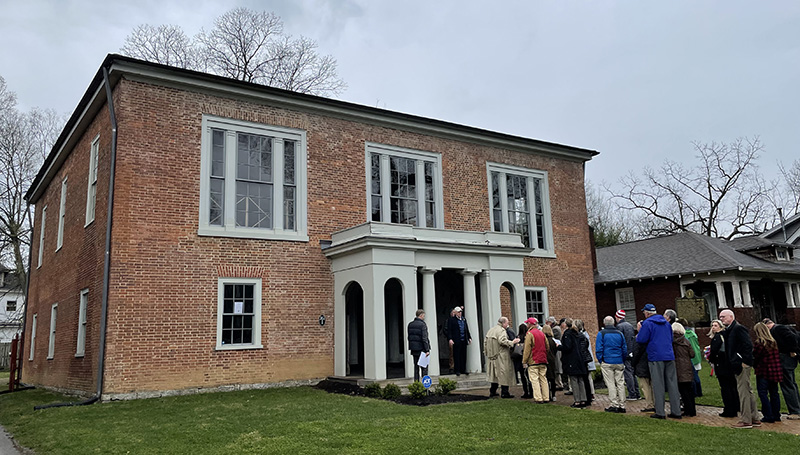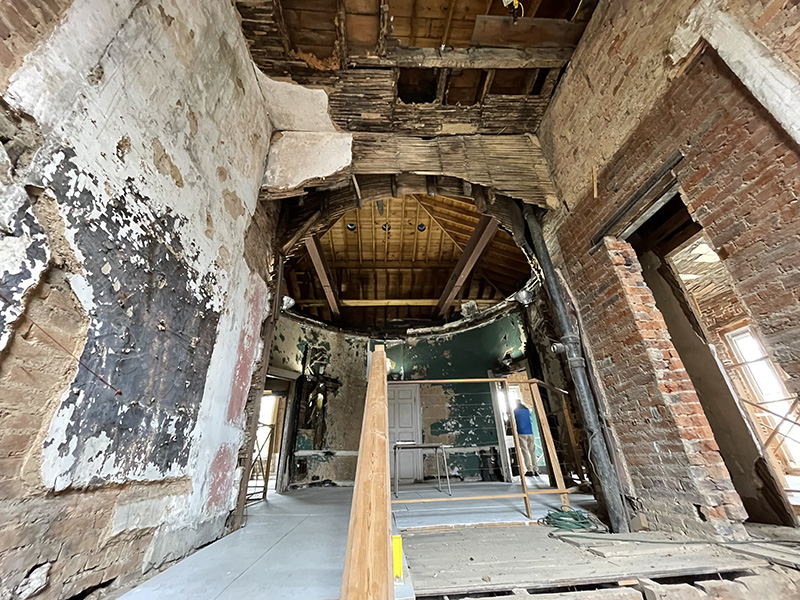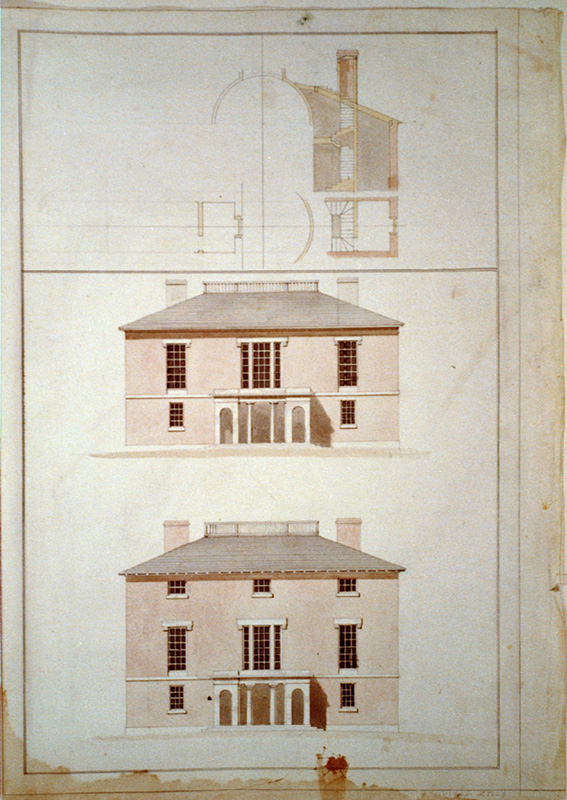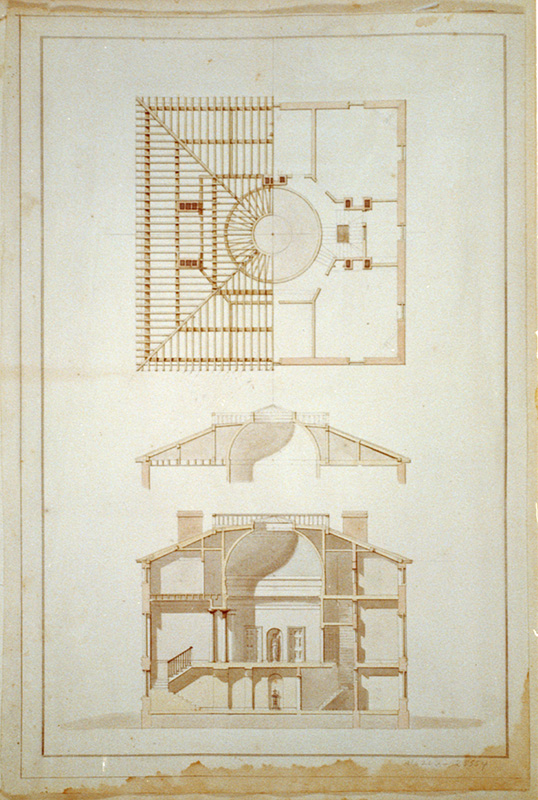Pope Villa: Latrobe’s Neoclassical Gem in Lexington
by Daniel K. Ackermann
During the Trust’s recent Kentucky Symposium, attendees explored the architectural shell of Pope Villa (figure 1) after enjoying Patrick Snadon’s fascinating lecture about this intriguing Lexington site. Pope Villa is an early-19th-century residence designed by architect Benjamin Henry Latrobe for Senator John Pope and his wife, Eliza.1 After a devastating 1987 fire, the house became the focus of intensive architectural and historical investigation. Since then, layers of alterations have been removed to reveal Latrobe’s original designs (figure 2) and their interpretation at the hands of local Lexington craftspeople, including the builder, Asa Wilgus.
The ongoing project to research and restore the house has underscored the skill of both Latrobe and Lexington’s craft community and the cosmopolitan nature of Lexington less than 20 years after achieving statehood in 1792. In fact, Latrobe himself wasn’t so sure that Lexington’s artisans could pull it off. He feared that his design for the Popes’ new house—with its sparse façade, hidden rotunda, and suite of apsidal second floor entertaining rooms—was far too urbane for the backwoods of Kentucky and its local craftsmen (figures 3 and 4). In one letter he apologized for having “perplexed and bewildered” the Senator and his builders with the plan he proposed.2
As Barbara Carson noted in her seminal work on Latrobe’s Octagon House, these fresh Neoclassical spaces were the stages for a new kind of ambitious sociability. Houses and rooms are containers for living. In the early Republic, luck of birth or wealth alone were not enough to establish successful standing. Rather, in a nation of economic and social mobility, one’s ability to participate fluently in rituals of sociability like dining, card-playing, conversation, and dancing determined who was in and who was out.3 Lexington’s elite merchants and politicians embraced this new style with its strongly geometric facades; three-part suites of large entertaining rooms that could be thrown open and linked together into larger and more flexible spaces; and rooms that were octagonal, round, oval, or apsidal. Henry Clay’s Ashland, Hopemont, and the Bodley-Bullock House are three other examples that Trust members saw in Lexington.
Latrobe was among the first professionally trained architects in the United States and a leading proponent of this new style. At Pope Villa, Latrobe created spaces for the Senator and his wife that seem to have embraced the architecture of government as its organizational structure. A pair of matched apsidal entertaining rooms on the house’s second floor mimicked the balanced chambers of the House and Senate. Latrobe’s use of a rotunda and oculus in the Pope House was also an allusion to the rotunda in Washington that linked the two houses of Congress. Indeed, architectural historians Patrick Snadon and Michael Fazio have suggested that Latrobe may have referenced his plans for the south wing of the Capitol with its staircase opening into a rotunda screened by columns in his plans for the Pope House.4
Latrobe also designed an addition for Ashland, Henry Clay’s house (figure 5), which was rebuilt by his son James Clay between 1854–1857. Latrobe’s plans for Ashland and the Pope House offered noticeably different approaches to democratic access and equality that reflect the two men’s differing political contexts. Pope’s house was meant to help him seek reelection to the Senate, an office chosen by his political peers in Frankfort, KY; by contrast, Clay sought election to the House of Representatives, who were elected by popular vote. Visitors to Pope’s house were guaranteed no more than a view into a dimly lit ground floor entry hall and perhaps access into either the Senator’s office or Eliza’s sitting room. Only those who were invited upstairs were privy to the secret of the house: a light filled rotunda and suite of entertaining rooms on the second floor. Visitors to Ashland, however, entered through a two-story portico into an octagonal entry hall. From the entry hall visitors could see straight through into Clay’s drawing room and into the octagonal dining room ahead and to the left even if they had no access to those spaces. Pope’s house was a democratic house for the democratic elite, whereas Ashland gave all front door visitors the impression of access into the social heart of the house.
Different though they were, both Pope Villa and Ashland were symbols of Lexington’s sophistication. Senator Pope’s opposition to the War of 1812 doomed his bid to return to the Senate, and he chose not to seek reelection. After his wife Eliza’s death in 1818, he left the house Latrobe designed and leased the property to William S. Dallum. In 1819, President James Monroe embarked on a tour of the western states and on July 4, 1819, the Dallums hosted a special dinner in his honor. Pope Villa and Lexington’s cosmopolitanism made the desired impression, leading President Monroe to remark that “the growth of this state, and of the whole Western Country, has surpassed what was ever seen before, in any part of the world.”5
- The most detailed overview of the architectural history of the Pope House can be found in: Michael Fazio and Patrick Alexander Snadon, The Domestic Architecture of Benjamin Henry Latrobe (Baltimore, Maryland: The Johns Hopkins University Press, 2006), 389-446.
- Ibid., 395-396.
- Barbara G. Carson, Ambitious Appetites: Dining, Behavior, and Patterns of Consumption in Federal Washington (Washington, D.C.: American Institute of Architects Press, 1990).
- Fazio and Snadon, 410-411.
- Quoted in Daniel Preston and Marlena C. DeLong, The Papers of James Monroe, vol. 1 (Westport, Connecticut: Greenwood Press, 2003) 715.
Daniel K. Ackermann, PhD is the Chief Curator & Director of Research, Collections, and Archaeology at Old Salem Museums & Garden & The Museum of Early Southern Decorative Arts. He delivered the Jonathan L. Fairbanks Lecture at the Kentucky Symposium and graciously assisted the Decorative Arts Trust team with hosting duties.
A print version of this article was published in The Magazine of the Decorative Arts Trust, one of our most popular member benefits. Join today!





